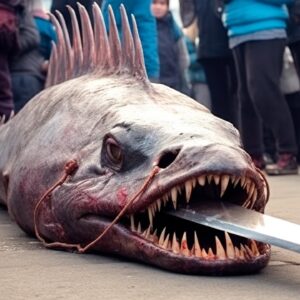The ocean is home to a myriad of fascinating and often fearsome creatures. While many are awe-inspiring and beautiful, others pose significant dangers to humans. Here’s a look at the 15 most dangerous ocean creatures in the world, each with its unique threats and adaptations that make them formidable adversaries in the watery depths.
1. Box Jellyfish
The box jellyfish, also known as the sea wasp, is one of the most venomous creatures in the ocean. Its sting can cause excruciating pain, heart failure, and death. Found primarily in the waters around Australia and Southeast Asia, it is often transparent, making it hard to spot.
2. Stonefish
Stonefish are masters of camouflage and can blend seamlessly into their surroundings. Their dorsal spines are venomous and can deliver a sting that causes extreme pain, swelling, and potentially death if not treated promptly. They are found in the Indo-Pacific region.
3. Cone Snail
The cone snail’s venom is a potent neurotoxin that can paralyze its prey in seconds. While it uses this venom to capture small fish and other prey, it can also be deadly to humans if not treated immediately. They are found in tropical and subtropical seas.
4. Great White Shark
The great white shark is often depicted as a dangerous predator, and with good reason. Its powerful jaws and sharp teeth make it one of the ocean’s top predators. While attacks on humans are rare, their sheer size and strength make them a significant danger.
5. Bull Shark
Bull sharks are known for their aggressive behavior and ability to thrive in both salt and freshwater environments. They are responsible for a significant number of shark attacks on humans due to their proximity to populated areas.
6. Portuguese Man O’ War
The Portuguese man o’ war is not a single organism but a colony of specialized polyps and medusoids. Its long, venomous tentacles can deliver a painful sting that causes nausea, difficulty breathing, and, in severe cases, death. It is found in warm ocean waters.
7. Blue-Ringed Octopus
Small but extremely venomous, the blue-ringed octopus’s bite contains a neurotoxin that can cause paralysis and respiratory failure within minutes. It is typically found in the Indo-Pacific region and its vibrant blue rings are a warning sign.
8. Sea Urchin
While sea urchins may look harmless, their spines can deliver a painful sting and are sometimes venomous. The pain from a sea urchin sting can last for days, and in some cases, the spines can cause infections if not removed properly.
9. Lionfish
The lionfish is known for its striking appearance and venomous spines. Its sting can cause severe pain, nausea, and respiratory distress. Native to the Indo-Pacific, it has become an invasive species in the Atlantic Ocean.
10. Tiger Shark
Tiger sharks are known for their aggressive feeding behavior and their large size. They have powerful jaws and are known to consume a wide variety of prey, including other sharks and marine mammals. They are found in tropical and subtropical waters.
11. Numbfish
Also known as the electric ray, the numbfish can generate electric shocks to stun prey and defend itself from predators. While not usually fatal to humans, the shock can be painful and disorienting.
12. Hammerhead Shark
Hammerhead sharks have a unique head structure that aids in hunting but can also make them dangerous. Their powerful bite and predatory nature make them a threat, although attacks on humans are uncommon.
13. Viperfish
The viperfish is known for its fearsome appearance, with long, needle-like teeth that can inflict severe injuries. It lives in the deep sea and uses its bioluminescence to attract prey in the dark waters.
14. Giant Squid
The giant squid is one of the largest and most mysterious creatures of the deep ocean. Although attacks on humans are not documented, its size, powerful tentacles, and beak make it a potentially dangerous animal.
15. Scorpaenidae (Scorpionfish)
Scorpionfish are equipped with venomous spines and are highly camouflaged, making them dangerous and difficult to spot. Their sting can cause severe pain and swelling, and in some cases, an allergic reaction.
Conclusion
The ocean is a realm of beauty and danger, home to some of the most extraordinary creatures on Earth. Understanding these dangerous ocean dwellers and respecting their habitats is crucial for ensuring safety while exploring the marine world. As you dive into the depths, always exercise caution and be aware of the potential threats lurking beneath the waves.





